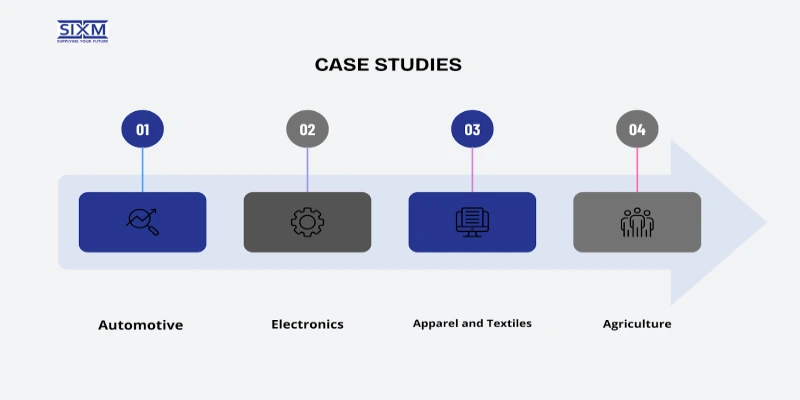In 2023, a quiet but historic shift took place when Mexico overtook China as the United States' top trading partner for the first time in two decades. The change was not sudden but the result of years of strategic moves driven by tariffs, nearshoring trends, and Mexico's growing manufacturing strength. Annual trade between the United States and Mexico now exceeds $ 500 billion, influencing industries from automotive to agriculture. The post-pandemic recovery further accelerated the demand for Mexico as a supplier, as companies in the USA sought suppliers that could deliver within days rather than weeks.
This blog will break down how Mexico's supply chain surpassed US imports as the outcome of trade policy, geography, shifting geopolitics, and its evolving nature.
Rise of Mexico in U.S. Import Rankings
U.S. Census Bureau data shows that Mexico now supplies about 15 percent of all goods coming into the United States, surpassing China, which holds roughly 13 percent. The growth has been fueled by strong performance in sectors such as automotive manufacturing, electronics, agricultural goods, and industrial machinery.
Between 2020 and 2024, Mexican imports grew at an average annual rate of around 6 percent, outpacing many other major trade partners. In 2019, the U.S. bought far more from China than from Mexico, but by 2024, the picture had changed entirely. Imports from Mexico climbed past 500 billion dollars, while those from China dropped to around 438 billion.
Decades of trust between U.S. buyers and Mexican suppliers, along with family-owned factories adapting to global standards, have created strong, reliable trade partnerships. These partnerships underscore that Mexico has emerged as a leading supplier to the United States, driven by shifting geopolitical and economic conditions and strengthened by its rapidly modernizing supply chain.
Key Geopolitical and Economic Factors Behind Mexico's Supply Chain Growth
U.S.–China Trade Tensions
Since 2018, the U.S. has imposed tariffs on hundreds of billions of dollars' worth of Chinese goods, with rates reaching 25% on machinery, electronics, and metals. According to the Peterson Institute for International Economics, by 2024, the average tariff on Chinese imports was more than six times higher than pre-2018 levels.
Higher costs pushed many U.S. companies to look for alternative suppliers. Mexico, with tariff-free access under USMCA and close proximity, became a logical choice for the USA.
USMCA Advantage
The United States–Mexico–Canada Agreement (USMCA), which replaced NAFTA (North American Free Trade Agreement) in 2020, updated trade rules to make regional manufacturing more competitive. Automotive rules of origin increased from 62.5% to 75%, pushing automakers to source more components within North America. According to Mexico's Secretaría de Economía, 2023 report, Mexico's auto sector, home to plants for GM, Ford, Toyota, and Volkswagen, made record exports of $78 billion to the U.S.
In addition to automotive growth, USMCA streamlined customs procedures and enhanced intellectual property protections, attracting more high-value manufacturing projects to Mexican industrial hubs.
Nearshoring Movement
Nearshoring to Mexico has accelerated as companies reevaluate supply chain risks. Kearney's 2024 Reshoring Index shows U.S. imports from nearshore countries rising by over 17% year-on-year, with Mexico leading the shift. For example, a container can reach the U.S. from Mexico in as little as 48 hours by truck, compared to 2–5 weeks from China by sea. That speed advantage became more critical during the COVID-19 pandemic, when Asian ports faced lockdowns.
Energy and Labor Costs
Mexico combines competitive wages with strong technical skills. In 2024, data from the International Labour Organization shows that the average manufacturing wage in Mexico is around $4.80 per hour compared to over $25 in the U.S., despite meeting high production standards.
Key industrial areas in Mexico enjoy a steady and reliable energy supply, supported by projects like the Monterrey VI aqueduct and new natural gas pipelines from Texas. Reliable access to resources keeps factories operating without interruption, from aerospace production in Querétaro to appliance manufacturing in Nuevo León. These facilities enable companies to avoid costly delays and maintain consistent, high-quality output, meeting the demands of buyers like the USA.
Transformation of Mexico's Supply Chain in Leading U.S. Imports
Infrastructure Upgrades That Boosted Trade Flow
A significant reason Mexico has taken the lead in U.S. imports is its heavy investment in infrastructure that keeps goods moving quickly.
- The Port of Lázaro Cárdenas is getting a $300 million upgrade to double container capacity and speed up customs clearance.
- The Port of Manzanillo, the busiest in the country, moved nearly 4 million containers in 2024 and is expanding to handle up to 10 million each year.
- In total, Mexican ports processed 9.38 million containers in 2024, a 12% jump from the year before, helping exporters deliver to the U.S. faster and more reliably than many overseas suppliers.
Industrial Parks and Clusters That Attracted Manufacturers
Mexico's network of over 400 industrial parks, strategically placed near highways, ports, and rail lines, has made it easy for global companies to establish operations.
- In 2022, more than 4.3 million square meters of industrial space were taken, a 30% increase from the previous year.
- Nuevo León had become a significant magnet for investment, landing projects like the Tesla gigafactory, which will supply vehicles and parts to U.S. markets.
With such ready-to-use infrastructure, Mexico was able to quickly take on production shifting out of Asia during trade tensions and pandemic-related disruptions.
Industry Specialization That Strengthened Export Value
Mexico's rise in U.S. imports is not only about moving goods faster but also about the type of products it exports.
- Querétaro has grown into an aerospace hub with over 40 companies making aircraft parts for brands such as Bombardier.
- Guanajuato and Nuevo León are major players in the auto industry, contributing to Mexico's car exports reaching a record 78 billion dollars to the U.S. in 2023.
- In Baja California, factories produce everything from medical devices to consumer electronics.
By building strength in several high-value industries, Mexico has gained a clear advantage over countries that rely on just a few main exports.
Modernized Customs and Logistics That Cut Delays
For years, border and port bottlenecks slowed trade between Mexico and the United States, but significant improvements have changed the picture.
- Digital customs systems now speed up paperwork, and updated cross-border trucking agreements make it easier for shipments to move directly between the two countries.
- At the Port of Lázaro Cárdenas, container traffic grew by 14 percent in early 2025, with automotive shipments increasing by 3 percent.
- In just six months, the port handled 13.4 million metric tons of cargo and nearly 900 vessels.
- Mexico also offers faster clearance and smoother transport routes, ensuring companies can plan shipments with greater certainty and keep production schedules on track.
Case Studies of Mexico Sector Shifts Driving USA Import

Automotive
- GM expanded its Ramos Arizpe plant to produce both electric and conventional vehicles for U.S. markets.
- Ford added hybrid and EV production lines in Hermosillo to meet rising U.S. demand.
- Tesla's planned gigafactory in Nuevo León will produce vehicles and battery components, directly linking to plants in Texas and Michigan.
Electronics
- HP and Dell have expanded their assembly in Baja California to meet U.S. demand quickly, improving inventory turnover and reducing the risk of supply chain disruptions.
- Apple shifted some component manufacturing from Asia to northern Mexico for faster delivery to North America.
Apparel and Textiles
- Brands partner with factories in Puebla and Jalisco for fast production cycles to serve U.S. markets.
- Small-batch manufacturing allows online retailers to test designs quickly and minimize inventory risk.
- Shorter shipping distances reduce transportation costs and carbon footprint.
Agriculture
- Greenhouses in Sinaloa and Michoacán enable year-round production of berries, tomatoes, and other crops to fulfill the demands of the USA.
- Expanded avocado exports from Michoacán with continuous shipments beyond peak season.
- Advanced cold-chain logistics ensure fresh produce reaches U.S. supermarkets in prime condition.
Future potential: Can Mexico Maintain Its Lead?
Mexico's position as a top U.S. trade partner looks promising for 2025–2030, with more investment likely in areas such as renewable energy, electric vehicle supply chains, and semiconductor manufacturing. Growth in these high-value sectors could make Mexico an even more critical supplier for the U.S.
However, long-term success will depend on stable politics, consistent trade policies, and maintaining secure and efficient trade routes that support long-term business confidence.
Ongoing Challenges for Mexico's Role in the U.S. Trad
Despite being the leading supplier for the USA, Mexico faces some challenges in trade.
Security Concerns in Certain Regions
- Some parts of Mexico still struggle with security issues such as cargo theft and organized crime, which can disrupt transportation and increase operational costs for exporters.
Competition from Other Nearshoring Locations
- Countries like Vietnam and India are emerging as strong competitors of Mexico by offering low labor costs and expanding manufacturing capabilities.
- Though they cannot match Mexico's proximity to the U.S., their aggressive incentives and growing infrastructure could attract specific industries.
Infrastructure Bottlenecks at Busy Border Crossings
- Despite infrastructure improvements, delays at major border crossings remain a challenge.
- Long truck wait times and customs congestion can slow shipments and disrupt time-sensitive supply chains.
Political Changes and Potential Labor Disputes
- Shifts in trade policy, labor laws, or environmental regulations in either Mexico or the U.S. can affect production costs and timelines.
- Growing labor activism in Mexico also raises the possibility of strikes or disputes that could temporarily halt manufacturing.
Addressing these challenges is essential to sustaining growth and reliability in cross-border trade. For a deeper look at these issues and practical strategies to overcome them, explore our guide on supply chain challenges, risks, and solutions.
Final Thoughts
Mexico's rise to the top of U.S. imports is the result of years of strategic investment, stronger industry capabilities, and a shift in global trade patterns. From modern infrastructure and specialized manufacturing hubs to trusted business relationships, the country has built a supply chain that delivers both speed and value. While challenges like competition, infrastructure bottlenecks, and political risks remain, Mexico's proximity, trade agreements, and growing expertise put it in a strong position to hold its lead. For U.S. businesses, Mexico is no longer just a nearby option; it is a critical partner in building resilient supply chains.
Build a Smarter Supply Chain with SIXM
Are you looking to cut lead times, reduce costs, and strengthen your supply chain?
SIXM connects you with trusted manufacturers and efficient logistics partners. Explore our Mexico product sourcing services to secure reliable production, streamline operations, and gain a lasting competitive edge. Start building a smarter supply chain with SIXM today.
Frequently Asked Questions (FAQs)
Mexico became the United States' most significant source of imports in 2023, surpassing China for the first time in more than two decades.
Mexico's top exports to the U.S. include automobiles and auto parts, electronics, aerospace components, agricultural products such as avocados and berries, and apparel.
Mexico offers geographic proximity, competitive labor costs, faster shipping times, tariff advantages under the USMCA, and a modernized supply chain that supports just-in-time manufacturing.
Upgrades to ports, railways, highways, industrial parks, and customs systems have streamlined logistics, reduced delays, and improved cross-border trade efficiency.
Security issues in certain regions, competition from nearshoring destinations like Vietnam and India, border congestion, and political or labor disputes could affect trade flows.

